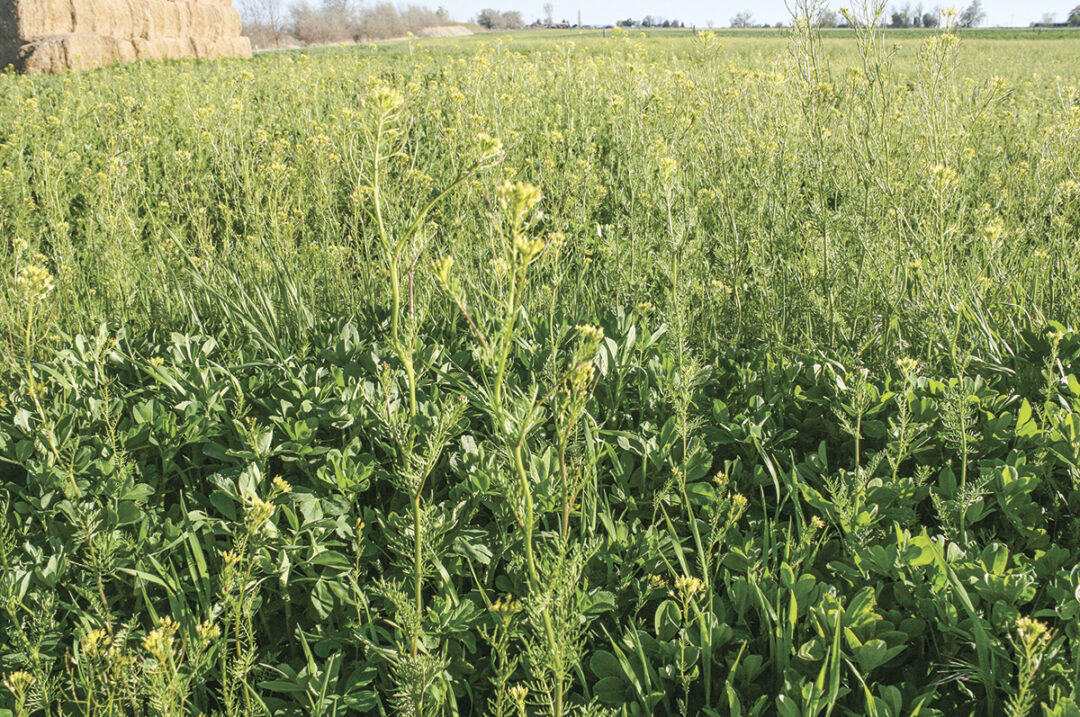Weedy alfalfa is often a concern when water resources are scarce. The weeds sometimes even seem to outcompete the alfalfa in extremely dry years. Weeds can impact forage quality and contribute to toxicities. Ultimately, this reduces the value of the forage and hits the pocketbook. Here are four reasons to make a plan to control weeds in your alfalfa stand:
1. Weeds in alfalfa can reduce protein content
When it comes to hay production, most producers choose alfalfa because it has a high protein concentration. As a legume, alfalfa has more leaves than stems. Since the leafy materials are where protein is found, pure alfalfa stands clearly have more protein than grass alfalfa mixes. When weeds propagate through a field unchecked, it can negatively impact the protein content of the produced hay. Of course, this is dependent on the weed species present, as some are higher in protein than others. It also depends on maturity level; in first cutting, immature weeds may contribute to a higher protein content. However, as the season goes on and the weeds mature, they will be more stemmy and less leafy. Therefore, more mature weeds will reduce the protein content in later forage cuttings.
2. Weeds in alfalfa can reduce forage quality by increasing fiber content
As stated above, more mature weeds are stemmy and less leafy. That means they are more fibrous than the legume forage surrounding them. Higher concentrations of acid detergent fiber (ADF) and amylase-treated neutral detergent fiber (aNDF) are indicative of lower-quality forages. Fibers impact animal palatability and digestibility. Livestock prefer low-fiber forages. In some instances, when fibers become too high, they may refuse the hay altogether. Of course, this is typically in grass hays. However, we have seen first-cutting hays with very high fiber contents come through Ward Laboratories Inc. Further, these fibers are the basis for the relative feed value (RFV) calculation. As these values increase, RFV decreases. Therefore, weedy alfalfa often has a lower RFV than a pure stand. Since RFV is often used to determine the price of the hay, weeds can directly hit a producer’s pocketbook. It would be wise for operations to weigh the cost of weed control to the prices they may receive. Controlling weeds may be one place producers can make an impact on their profit margin.
3. Weedy alfalfa is higher in nitrates
Common weeds such as pigweed or lamb's-quarters are nitrate accumulators. I typically advise producers that nitrates aren't of concern in alfalfa unless it has been under extreme stress (such as drought). However, if the stand has a high number of weeds, it may be wise to analyze nitrates. As a reviewer, I am often surprised at the number of alfalfa hay samples I see with high nitrate levels due to weeds.
4. Some weeds may have other toxic attributes to be aware of
Finally, some weeds can contribute toxicities that we do not have the capabilities to test for to assess the risk. One such weed is nightshade. Nightshade has a compound called solanine, which is toxic to animals and can cause death losses. Each year, I get a couple of inquiries about baled hay with nightshade weeds visibly present or the producer having knowingly baled the forage with the weeds. There is no lab I have found willing to test for the toxic compound and give the green light for feeding. The risk is simply too high. There are, however, veterinary diagnostic labs with the capability of determining if this compound was in the feed and the cause of death.
So this example of nightshade toxicity is to stress the importance of doing in-field observations and knowing what weeds are present in your hay stands. Could weedy alfalfa be contaminated with a toxin not worth messing with? Absolutely!
In conclusion, weedy alfalfa stands can reduce nutritional value and forage quality as well as have the potential to cause real livestock health concerns through nitrates or other toxins. Weeds can reduce RFV and hurt the price received for sold alfalfa and negatively impact animal performance. Nitrates and other toxicity risks increase with more weeds in the alfalfa stand.












